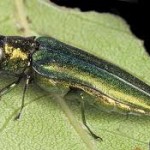 Emerald Ash Borer (EAB), Agrilus planipennis Fairmaire, is an exotic beetle that was discovered in southeastern Michigan near Detroit in the summer of 2002. The adult beetles nibble on ash foliage but cause little damage. The larvae (the immature stage) feed on the inner bark of ash trees, disrupting the tree’s ability to transport water and nutrients. Emerald Ash Borer arrived in the United States on solid wood packing material carried in cargo ships or airplanes originating in its native Asia. The adult beetle is metallic green and approximately 1/2 inch long. Due to this infestation, firewood cannot be moved in many areas, including Iowa. Click here for the the most recent information on EAB and see how you can help control this beetle.
Emerald Ash Borer (EAB), Agrilus planipennis Fairmaire, is an exotic beetle that was discovered in southeastern Michigan near Detroit in the summer of 2002. The adult beetles nibble on ash foliage but cause little damage. The larvae (the immature stage) feed on the inner bark of ash trees, disrupting the tree’s ability to transport water and nutrients. Emerald Ash Borer arrived in the United States on solid wood packing material carried in cargo ships or airplanes originating in its native Asia. The adult beetle is metallic green and approximately 1/2 inch long. Due to this infestation, firewood cannot be moved in many areas, including Iowa. Click here for the the most recent information on EAB and see how you can help control this beetle.
The Warren County Conservation Board, in August of 2013, banned the importation of firewood into WCCB areas in an effort to help fight the spread of the this insidious insect. You can view the full resolution here.
The Iowa Department of Natural Resources page.
December 15, 2014 Iowa DNR emerald ash borer press release:
FOR IMMEDIATE RELEASE: DECEMBER 15, 2014
www.iowadnr.gov | facebook.com/iowadnr | twitter.com/iowadnr | pinterest.com/iowadnr
MEDIA CONTACT: Tivon Feeley, Forest Health Program Leader, Iowa Department of Natural Resources, 515-725-8453.
EMERALD ASH BORER CONFIRMED IN FIVE COUNTIES IN SOUTHERN IOWA
DES MOINES – The emerald ash borer (EAB) has been positively identified for the first time in rural Iowa, after eight larvae were collected as part of an investigation in eastern Lucas County on November 25.
Investigators noted a number of ash trees in advanced decline, giving the appearance that the invasive beetle had been there for several years, prompting them to expand their search area leading to additional confirmed infestations in Appanoose, Mahaska, Marion and Monroe counties.
- Lucas County – A forestry contractor found dead ash trees with heavy woodpecker flecking while completing a timber stand improvement project on
privately-owned woodland on the far eastern edge of Lucas County, 3/8 of a mile from Monroe County. - Monroe County – EAB team members continued to examine trees in the area and additional larvae were found in ash tree on public property in Monroe County, near the Lucas site.
- Marion County – Larvae were found in a heavily-flecked ash tree on public property on the edge of Marysville.
- Appanoose County – Larvae were found in a tree along train tracks in Moravia.
- Mahaska County – Larvae were collected from a tree on private property on the north side of Eddyville.
These most recent positive confirmations bring the total number of Iowa counties where emerald ash borer has been found to 18. A statewide quarantine, issued on Feb. 4, 2014, remains in place and restricting the movement of hardwood firewood, ash logs, wood chips and ash tree nursery stock out of Iowa into non-quarantined areas of other states.
“It is extremely difficult to identify when emerald ash borers are new to an area. Trees may be infested for five years or more before woodpecker flecking, which is the most obvious calling card, is noticed by anyone, and by then tree mortality will become evident,” said Tivon Feeley, forest health program leader with the Iowa Department of Natural Resources.
EAB kills all ash tree species and is considered to be one of the most destructive tree pests in North America. Feeley encouraged Iowans who live in counties where EAB has not been confirmed to contact their district forester if they notice suspicious changes to their ash trees.
To learn more about EAB and other pests that are threatening Iowa’s tree population, visit www.iowadnr.gov/eab.

